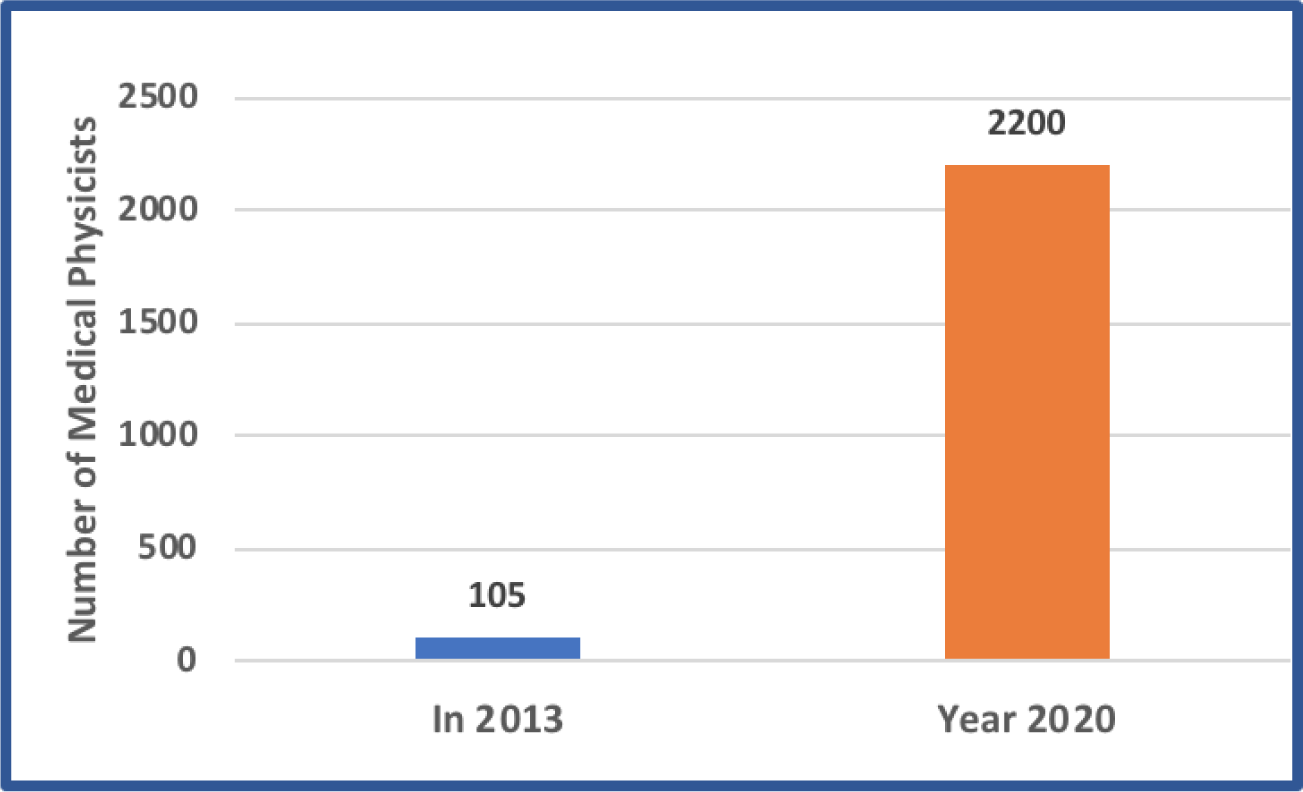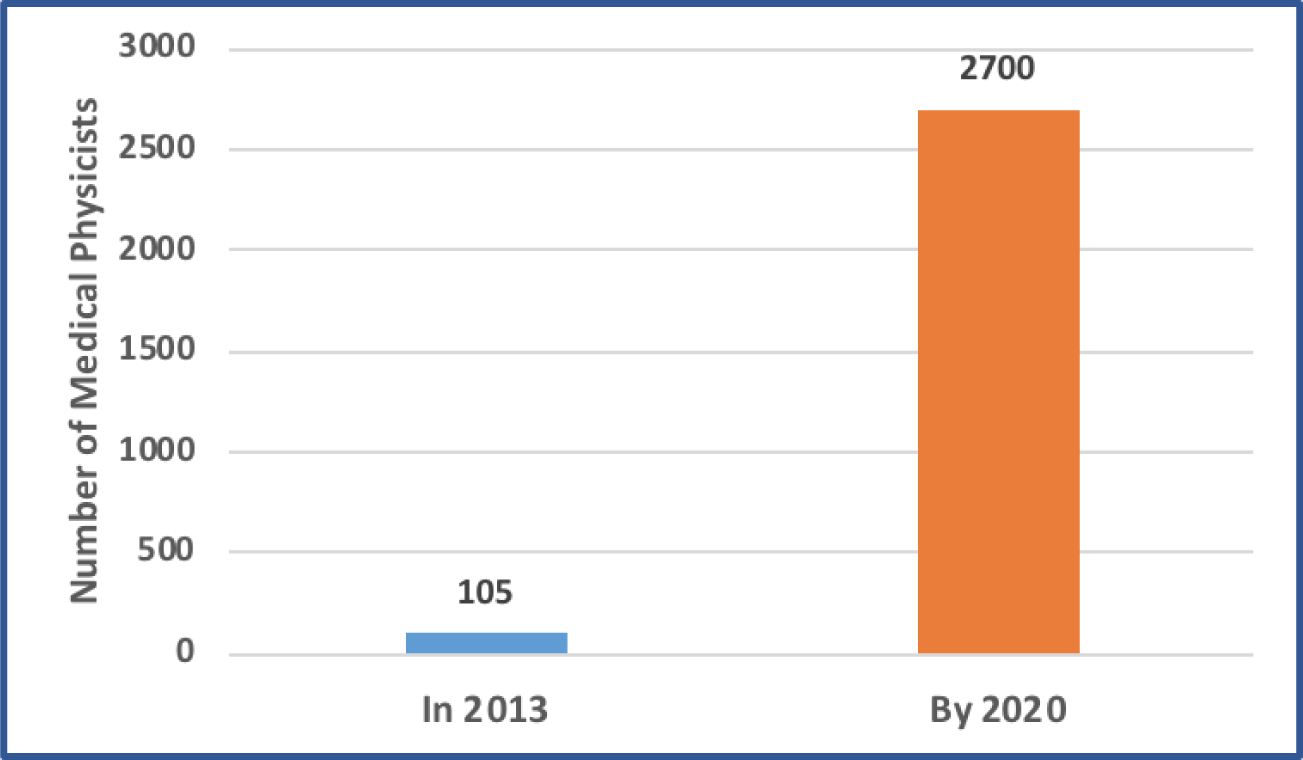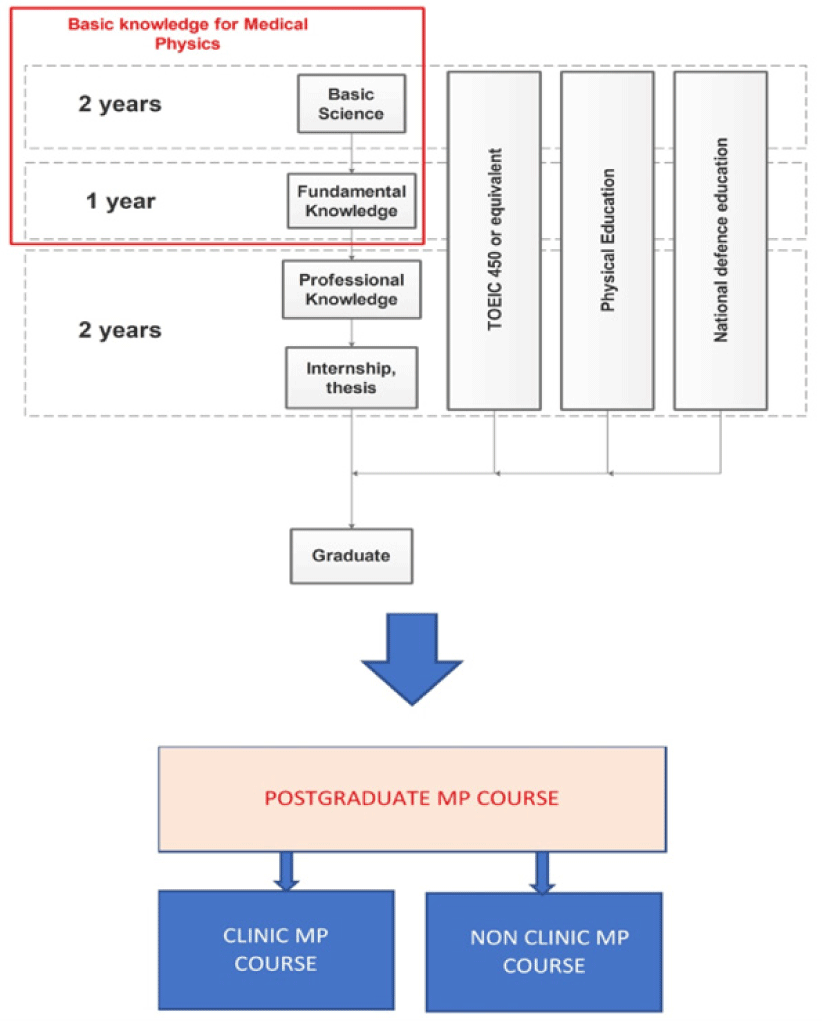Medical physics, current status and demand on human resource development and medical physics training in Vietnam
The Medical Physics is a profession that applies the physical laws, knowledges and phenomena of physics to medicine and biology in order to serve public health care. The medical physics is recognized as the independent profession in the health care sector according to recomendation of the International Atomic Agency (IAEA) and World Health Organization (WHO) [1]. The medical physics is a bridge between physics and medicine; the medical physicists are connecting the physicians with equipment. They keep a vital role in radiotherapy, diagnostic imaging and nuclear medicine that were specified in the International Basic Safety Standard (BSS) [2]. Their primary responsibility is to maintain radiation protection in radiation medicine. In the above - mentioned medical practices, the medical physicists are in charge of the following main issues: justification of medical exposures; optimization of protection in design and operational considerations; carrying out dose calibration, calculating patient doses; setting up the diagnostic reference levels and quality assurance and quality control (QA/QC) program; participating in treatment planning and investigating accidental medical exposure; administrating the release of patients after receiving radioactive substances into body or taking the responsibility of radiation protection officer.
The medical physicists are always facing the numerous and complex legal and ethical regulations, perhaps more so than any other professions in the medical practices. Because, they have not only to follow the medical obligations and professional ethic requirements, but they also have to comply with the mandatory requirements of radiation protection regulations in the relation to the ionizing radiation. They must to obtain the regulatory license when starting to work with radiation and follow the standard requirements in education and training before starting their career in hospitals.
For the last 10 years, the application of radiation and nuclear technology in Vietnam have made a leaped development. At present, according to the statistics as of 2015 of the Vietnam Agency of Radiation and Nuclear Safety (VARANS) [3], whole country has 29 radiotherapy departments with 13 sources of radiotherapy and 34 accelerators and about 3642 medical X-ray facilities with 6049 X-ray machines including many computed tomography scans (CT), modern angiography in operation and 32 nuclear medicine departments that use radio-pharmaceutics in diagnose and treat diseases; many new technologies are being exploited such as nuclear bullet implant technology to treat prostate cancer. The Positron Emission Tomography (PET) and dual PET-CT techniques are being effectively used in the early diagnosis of cancer. Although the Government has drastically invested in equipment, but the actual demand of society on these still does not meet yet. Moreover, at present time, Vietnam does not have enough the qualified medical physics human resource. In consequence of that, this might lead to low effectiveness in using the modern equipment and technology in the diagnosis and treatment of diseases in general and in cancer treatment in particular. In the result of that, the expenses on health care service will be very high with the limited quality. Without the well trained medical physicists, the numerous serious radiation risks to the patients might occur and might even cause the fatal accident.
On the other hand, according to the present regulations, the medical physics is still not yet recognized as the health profession. There are no clear provisions of the role, duties and responsibilities of medical physicists in medical practices. In many various regulations, there are no any specific requirements on education and training for medical physicist. That might generate misunderstanding in recruiting personnel for medical physicist’s job positions, that is very important to radiation medicine.
In the education system, there is no code of training and code of profession for medical physics. There are only the codes for engineering physics (525204) and nuclear engineering (524401) and other professions that were stipulated in the Circular 14/2010/TT-BGDDT (2010) [4]; Most of physicists, who are now performing the medical physicist’s jobs in the hospitals, we call them as “existing medical physicists”, were graduated from various technical disciplines. Many of them have fundamental knowledge in physics and might have a chance to attend some short courses on various topics of medical physics provided by the suppliers or participate in the short training courses. So, they might not fully satisfy with the training requirements of the BSS [2] for clinical medical physicists.
Facing the serious shortage of medical physicists; recognizing the important roles of medical physicists in medicine and with a desire to successfully apply the scientific and technological achievement in the atomic energy field into public health care, The Prime Minister has signed the Decision No 1958/QD-TTg approving the Masterplan of development & application of radiation in medicine by 2020 [5]. In this Decision, the Prime Minister has requested all the ministries and relevant stakeholders to strengthen the training of medical radiation practitioners in general and medical physicists in particular by promoting different levels and types of training; proceed to ensure that medical radiation facilities especially all radiotherapy departments must be equipped with enough number of medical physicists with a suitable accreditation. Accordingly, by 2015 the following goals of the Masterplan should be achieved: enhancing the training human resources in nuclear medicine, radiation therapy, and diagnostic imaging in order to satisfy the requirements; drawing a special attention to training human resources in medical physics; Developing curriculum, syllabus; setting up the accredited procedure for medical physicist.
In Vietnam, before August 2017, there no formal academic education programs for medical physics were available. However, there are a number of universities such as the Universities of Sciences of Hanoi and Ho Chi Minh recently have been conducting the academic education courses in engineering physics and nuclear engineering or nuclear physics with some limited oriented topics related to medical physics.
According to the report of the Vietnam Medical Physics Association of 2014, until 2013 the whole country had about 105 “so called existing medical physicists”. Most of them are now performing treatment for the patient with no full professional knowledge of medical physicist such as: radiobiology, radiation physics, radiation protection dosimetry, anatomy, image processing, treatment planning etc. In result of that, they might not consider enough to the potential radiation risks, which can make an innjury to patients and might not be able to perform the current sophisticated treatment techniques.
In accordance with the Prime Minister’s Decision No. 1958/QD-TTg [5], the development of radiotherapy and nuclear medicine departments by 2020 requires to achieve the development rates as the followings: one radiotherapy unit and one gamma scan unit per millions of people; 80% of provinces and cities have to be equipped at least 01 digital angiography equipment; 80% of regional hospitals have 01 CT; 100% of district hospitals will have X-ray machines. To meet these criteria, the number of medical physicists will be required at a high level, it was estimated over 2300 people.
Additionally, the number of new cases of cancer in Vietnam has been increasing significantly for the last decades. According to public information available in the Vietnamnet web site (2016) [6], there are about 126.000 new cases of cancer per year in Vietnam. So, by 2020, it is estimated about 190.000 new cases of cancer. According to the Manual of the American College of Radiation Oncology (ACRO) [7], if every medical physicist is responsible to take care of 70 patients with high technologies like Intensity-Modulated Radiation Therapy (IMRT), Image-guided radiation therapy (IGRT), Volumetric-Modulated arc Therapy (VMAT), the country needs about 2700 the medical physicists. This might conclude that by 2020, Vietnam will suffer from a serious shortage of the medical physicists in both quantity and quality.


In relation to the medical physics education and training issue, at the end 2015, IAEA has sent a report to the Government of Vietnam. In the VIE travel report_ Meghzifene-2015 [8], IAEA has recommended Vietnam to develop as soon as possible the academic education program of medical physics in compliance with to the IAEA standard education program [9] in aim at ensuring safety and enhancing the effectiveness of use of radiation in the medical care. In addition to that, in order to upgrade the knowledge for the “Existing Medical Physicists”, Vietnam needs to develop a supplementary program for transitional period. IAEA will support the Vietnam to develop this kind of program. Moreover, IAEA will also support Vietnam to develop an education and training capacity for the medical physics through implementation of the Technical Cooperation (TC) project on building education program of medical physics in period of 2018-2019.
Proposed resolution and education program of medical physics in NTTU
Being aware of the needs of training in medical physics – the new health profession in Vietnam, NTTU has developed the undergraduate education program (Bachelor program) in medical physics based on the IAEA standard education program in Training Course Series - TCS 56 [9] that was endorsed by the International Organization for Medical Physics (IOMP).
The general goal of the medical physics training and education program of the Nguyen Tat Thanh University is to develop the manpower for medical physicists. They will be provided with: the solid scientific background and professional knowledge; the good medical ethics and the high professional skills as well as a research and creative ability; They will be able to apply practical skills and theoretical knowledge into practices for ensuring the high safety and quality in treatment and diagnosis of disease, particularly in cancer treatment.
In addition, the NTTU’s Bachelor program of medical physics was prepared to achieve the following specific objectives:
1) The learners can achieve the basic knowledge of social-politic sciences, natural sciences, medicine and professional knowledge of medical physics; to have a good health and necessary English skill in order to better serve public health care; to contribute to social-economic development and self - improvement as well, 2) The learners can apply the professional knowledge of radiotherapy, nuclear medicine, and diagnostic radiology into practices such as medicine (as a health care specialist); scientific research (as a researcher); business and service (as a business-man); regulatory management (as a regulatory officer), 3) The learners are educated to become the persons, who is having the ethics, personal and professional skills, and team work skills as well to be able to work in healthcare sector and other related organizations, such as state management agencies, research institute, business and service centers in the context of worldwide integration became deeper and deeper, 4) The learner can obtain an enough knowledge about economics, politics, legislation; sufficient professional knowledge of medical physics in order to improve quality of treatment and diagnostic; to be able to deploy new techniques and technology transfer; To be able to provide consultancy and development of the new technical procedures for treatment and diagnostic; to participate in the research projects and to work in related stakeholders (business or service companies).
Based on the CDIO (Conceive – Design – Implement – Operate) format syllabus, the bachelor program of Medical Physics aims to support students to achieve the following four basic outcomes: 1) To acquire core knowledge of Medical Physics; 2) To develop self – discipline to be able to discover a knowledge, to solve problems, to think systematically and to master technical skills as well as personal ones; 3) To develop communication skills and teamwork skills; 4) To develop the capabilities for creativity as well as for design, for implementation and operation to contribute to the development of public healthcare, socio – economic and international integration.
The training program in medical physics was designed in such manner to compliance with both of national and international standards: In the first two years, the students will study the basic general disciplines in according to the national frame of standard training syllabus defined in Decision 67/2008/QD-BGDDT [10] and for the next following three years, the students will study the fundamental and professional disciplines in compliance with the international standard program IAEA TCS-56. The NTTU has to choose this approach because the Vietnam regulations [11] do not allow to conduct the post-graduate course in medical physics without the teaching the Bachelor of Science program in the same subject.
On 31/8/2017, the Ministry of Education & Training signed Decision No 3167/QD - BGDDT to authorize the Nguyen Tat Thanh University to conduct a pilot official education program in Medical Physics. This is the first official academic education program in medical physics in Vietnam. This is one great step forward to implement the directions of the Prime Minister, that were mentioned in the Decision 1958/QD-TTg
After completing the undergraduate course, the students will be able to joint to two years post-graduate course: the clinic training course, that designed for medical physicists working in hospitals or the non-clinic training course for other sectors (See Fig 3). The purposes of the clinical training course for medical physicists specialized in either radiation oncology or diagnostic radiology or nuclear medicine is to get more professional skills and experience to become the independent practitioners who can work without under supervision but with high safe and professional standard.
The deficiency of medical physicists generated the bad effects not only on the medical sector but also on the education and training one. This is a big challenge for education system because of lack of qualified medical physics lecturers. So, to overcome this problem, NTTU has pad a great attention to the train trainer program to have qualified lecturers. At present, NTTU has sent young lecturers to abroad for studying the post graduate courses of medical physics under sponsorship of IAEA.
Recently, IAEA has announced that TC project VIE6030 “Developing Education and Training Program for Medical Physics” has been approved by the Board of governors for period of 2018-2019 and NTTU was assigned as a counterpart of the Project. The TC Project VIE6030 consisted of three main components: Training trainer, providing expert missions for preparing syllabus and necessary equipment for training purposes. In the frame of this cooperation, The NTTU will build technical and human capabilities for ensuring to educate medical physics in compliance with international and national standards.
For successfully running the education program in medical physics, The Nguyen Tat Thanh University highly appreciates the national and international co-operations and considers it as a key element in human resource development in order to meet the actual demand of development and application of an advanced achievement of science and technology in atomic energy field into the health care sector. Nguyen Tat Thanh University have already co-operated with some hospitals and research centers in Ho Chi Minh City such as Hospital 175, Cho Ray Hospital, Center for Nuclear Techniques of HCM City in order to facilitate students in study by providing good practical environment. Alternatively, NTTU also enhances the co-operation with foreign partners such as IAEA, Universities of Malaysia, and Taiwan Universities. Some cooperation agreements have been signed for exchanging expertise and training of staff.
Conclusions and acknowledgment
The paper presented the comprehensive analysis on the current status of training in medical physics in Viet Nam as well as the current and future medical physicist human resource demand in order to meet the development requirement of the society. The paper also provided the basic information to readers for clearly understanding the roles and responsibilities of medical physicist in radiation medicine, who is playing the primary role in radiation protection and safety for patients and in reducing the radiation risk to public and in providing the good services for increasing the high quality in diagnostics and treatment, particular in cancer therapy; to avoid confusion between the medical physicist with other medical practitioners. The paper also provided the necessary information to relevant regulatory bodies to take the necessary actions to officially recognize medical physics as the new health care profession.
On this occasion, on behalf of NTTU, the authors expressed their sincere thanks to all functional departments of the Ministry of science and technology, the Ministry of Health, the Ministry of Education and Technology, International Atomic Energy Agency and other national and international institutions for their enthusiasm in co-operation and supports to develop the first Medical Physics education program in Vietnam and turn it become true. The research team also acknowledges the Organizer of the 1st Annual National Vietnam Medical Education Conference for giving the team to present its works at the Conference 2017.

